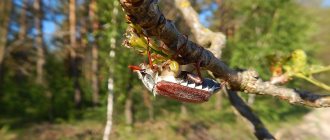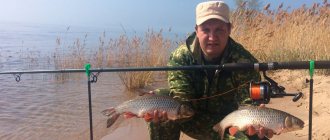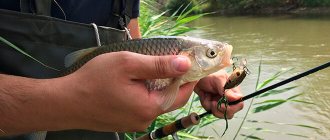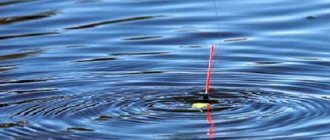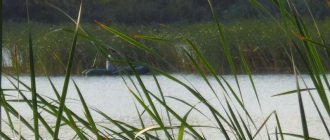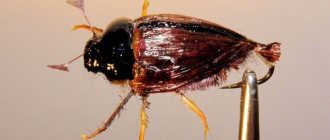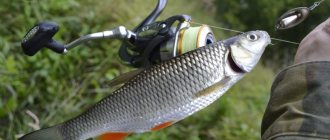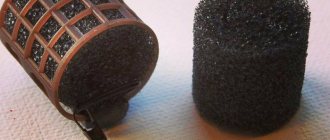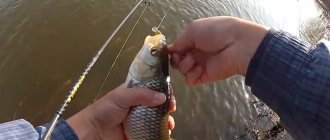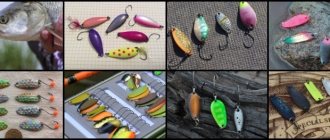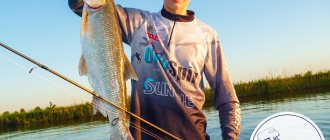Features of catching chub using the cockchafer
The chub is a predatory fish, and it is caught using various lures and lures. Spring chub hunting with the help of the cockchafer is one of the most exciting, since the chub at this time takes the bait much easier than in other periods.
Many fishermen consider this fish to be capricious and too shy and difficult to catch. But everyone who has studied the weak points of a predator well enough catches it without any problems.
Bugs for chub fishing
Catching chub with a beetle
“Bug” is a surface bait designed to catch a wide variety of fish. Today we will look at the process of catching chub. We will catch it on the Yuryuzan River in one of the most iconic places, next to the Sabakaitash rock.
The width of the river in this place reaches 50-70 meters, the transparency of the water today is 2-3 meters. Operating time: mid-September, cloudy outside, occasional rain, air temperature not lower than 10 degrees.
Our gear is as follows: spinning rod 2.2-2.4 meters long, test 5-21 grams, main line 0.2 millimeters, bombard 10 grams floating, leash 0.16 millimeters long 1.2-1.4 meters.
We are located below the rift, there is a hole in this place, and to our left there is an island. The river, going around this island, forms a backwater behind it with standing water and a clearly defined boundary with the current.
We start catching with a beetle measuring 20 millimeters, weighing 0.6 grams, in the color “yellow with black dots.”
We cast to the opposite bank; when falling, we hold the line a little so that the bait slightly overtakes the bombard before falling, and straightens the leash when falling. After the fall, we take out the slack in the fishing line and begin slow retrieving. When retrieving, the beetle dives 5-10 centimeters into the water, shaking its sides. This type of equipment allows you to make significant pauses during wiring. There are two ways to bait:
- we hold the spinning rod high, not allowing the main line to be placed on the water, and make a slow reel in a straight line;
- After casting, lower the tip of the spinning rod to the water and place the fishing line on the water. Under the influence of the current, the line is pulled into an arc, and we begin to float our bait downstream. After the bait has fused, we begin to slowly reel it in.
In the very first meters of the beetle's movement, we got a bite, but no fish were caught. We continue the wiring, after a few seconds another bite follows, but again we failed to detect the fish. We do a reboot. On the second cast, luck smiles on us and we get a successful bite. We take out a chub measuring 150 grams.
We continue casting. Having pulled out several chubs, we decide to change the color of the beetle to orange. A few idle wires, and a bite follows again. The change in color does not bother the fish. Today the bites are quite sluggish, there are no sharp blows. Bites are expressed in sluggish stretches; here there is no need to rush into hooking. It is necessary to take a short pause, allowing the fish to swallow the bait, and only then hook.
The beetles have quite bright colors. Despite the autumn, this does not bother the chub at all, and the number of bites does not fall due to this, proving the fact that the “Bug”, in general, is a universal bait, and fishing with it can be carried out throughout the season.
Beetle 20mm
Beetle 20mm
How to catch chub using a cockchafer?
The beginning of catching chub with a cockchafer can only begin when this beetle has flown out. This usually occurs in late April and early May.
When the cockchafer first appears, the chub is very careful towards this insect and it bites very rarely. But when the beetle’s flight is in full swing, this fish reacts to it by sharply intensifying its bite.
Usually during this period chubs are caught using one rod, since it was at this time that the spring ban on the use of two or more hooks was introduced.
The use of different bite alarms is not advisable, and noise can scare away this fish, especially when fishing close to the shore, where at this time it is mainly in search of food.
To catch chub with a cockchafer, you need to cast; this technique is most suitable and most effective. At the same time, you need to know that the chub is a cautious fish and the fisherman needs to behave very carefully.
Where to find the cockchafer
Everyone understands that you need to catch the cockchafer in May. But the word “catch” is said loudly; it would be more correct to say “collect”. The most common habitat of the cockchafer is maple , oak or linden . A lot of these beetles fly near the bushes in the evening.
The easiest way to find cockchafers is to hit the trunk with a stick and collect those that have fallen. You can also just look near a lighted place, there should be a lot of them there, since they love light very much and flock to it.
In the jar where the beetles will be kept, you need to add some leaves from the tree where the “bait” was found.
Video show about catching chub on Mayfish. Lots of interesting and useful things, let's take a look.
Conditions for catching chub
To make chub fishing a success, you need to adhere to the main points:
- When fishing, behave secretly.
- do not stand out at the fishing spot.
- keep quiet.
- hide in bushes and tall grass or fish from a cliff.
- use bait according to the season.
- use gear with natural drift of the bait.
- Fish in warm, calm weather or with little wind.
When there is a north-east wind, you should not go fishing, as it indicates the approach of a rainstorm, and the chub will not be hooked at such times.
Place for catching chub on a beetle
In order to detect the location of the chub, you just need to throw a few cockchafers on the water near the shore and wait a little.
After some time, the water will show several breakers, indicating that the chub noticed the beetle and began hunting for it.
Usually the chub is found on the riffles, near flooded trees, but you can also find this fish on calm currents.
The chub has excellent eyesight, it is timid and distrustful. The best location for a fisherman is a place near the shore in the bushes.
When fishing, casts need to be made to different places several times, and this needs to be done against the current.
This fish prefers places with fast currents:
- rapids.
- river bends.
- channels between the islands.
- in places where currents meet and the water is rich in oxygen.
- on large rivers, it is preferable to go to the outback near the shore, in calmly flowing waters.
Often the chub stops in holes, so casting must be done immediately before entering them.
Time to catch chub with a beetle
The most suitable time for fishing and catching chub is mid-May. He stops being careful and picks up all the cockchafers he notices.
In the spring, the bite of this predator can continue throughout the day. But the peak of activity occurs in the morning, from 7 to 8 o'clock and in the pre-sunset time, from 18 to 19 o'clock.
The main thing in this matter is calmness and noiselessness, since this fish can be scared away very easily. Night fishing for chub can also be successful, as large predators come out to hunt at this time.
But such fishing requires sufficient experience and certain skills. First you need to learn how to catch chub in the daytime.
Note
After two or three casts (in the absence of bites), the beetle with the hook begins to sink. On the surface of the water it is no longer noticeable. Before attaching the beetle, it is necessary to place a foam ball with a diameter of 0.5 cm on the hook. On a hook made of thin wire, the beetle lives longer, i.e. moves its paws, and this produces the effect of a naturally floating bait. How to find a chub site? Throw 3-4 beetles into the water closer to the shore and a little further. Watch the swimming bugs. You will see at what distance breakers appear on the water - this is a sign that the chub is out hunting.
Tackle for catching chub on a beetle
For chub fishing, both spinning rods and fishing rods are used. For a flat and sandy shore, a spinning rod is more suitable for casting away from you. From a steep bank, you can catch your gear on branches and bushes or snags, and here a regular fishing rod will help out.
It is most preferable to use a plug-type rod to catch cockchafers. It is stronger than its telescopic counterpart. This is important because the chub is a strong fish and strong tackle is needed to catch it.
Characteristics of the most optimal gear for chub fishing:
- light fishing rod – 2000.
- inertia-free reels for 2500.
- the length of the spinning rod or fishing rod is from 2.4 m.
- fishing line made of braided cord with a diameter of 0.14 mm.
- leash with a diameter of 0.16 mm made of monofilament.
The best choice of fishing line would be sbirulino, equipped with a floating float or with a fly rod. Spinning test class – up to 25 gr. In this type of cockchafer fishing, preference should also be given to the main braided line.
But many fishermen believe that monofilament line is better. She will make all the tackle as soft as possible, the bait delivery will be thinner and pull up more smoothly. In this case, the fish will be caught with greater confidence.
Choosing a place and time for catching chub using a cockchafer
Catching chub in May using a cockchafer turns out to be most effective in rivers with any current strength. Prey is often found in places where it is necessary to resist the flow. Another favorite place is underwater snags, as this is a convenient hiding place to wait for prey. It is better to cast the cockchafer to a depth of 2.5-3 m.
Read more
Mebaru balancers
The choice of place and time of fishing greatly influences the amount of catch. We recommend occupying fishing spots during dawn or 1-2 hours before sunset. At night, the beetle is thrown into the middle layers of water, and during the day they are carried out along the surface. Catching chub in the spring with a float rod is one of the most effective fishing methods, as the predator swims to the shore and waits for the beetles to fall from the adjacent trees.
It is better to throw bait and groundbait to catch a predator:
- under bushes and trees hanging over the water;
- close to snags;
- in places of variable current strength;
- in areas of difference in depth.
Chub can be found in rivers with moderate or fast currents
If you plan to fish with a donk, before adding the bait, feed the area with a mixture with the addition of components of plant origin; maggot is especially effective. Large specimens do not bite right away, you should be patient, the result will be worth the wait.
Equipment for catching chub using the cockchafer
In chafer fishing, the float performs the function of delivering the bait, in this case the chafer. You need to choose the right weight of the float, this will help you cast longer distances. The float must be of the floating type.
Experienced fishermen will like sbirulino, consisting of:
- float
- rubber bead - a damper that protects the windbreaker assembly from the impact of the float.
- Palamar knot with swivel.
- leash with hook 1.5 m.
Many people use transparent floats, in which half of the internal volume is occupied by water. The weight for chub hunting must be sliding. With its help, the sensitivity of the gear becomes significantly higher. The selected hook must have a short shank, minimum size 8.
Fishing for cockchafers on top
Of course, in various regions of the country during the period of the emergence of the beetle, fishing for the cockchafer, freely swimming on top, becomes one of the most popular and productive. And it has been like this since time immemorial. And these days, beetles are successfully caught from above, using a conventional wire telescopic rod paired with a spinning rod, as well as a self-loading float of three to four grams and a leash, with the help of which the beetle is moved away from the float by 1-1.5 meters. Moreover, the beetle floats in front of the float, which is done specifically so that the alarm does not unnecessarily alert the fish.
When fishing with this method, the floating float must carry the line from the reel spool with it impeccably smoothly, there should be no jerks, since unnatural jerks are transmitted to the bait floating on top and this alerts the chub, and even more so a large suspicious ide. To make the line come off the spool smoothly, you can use your hand. This technique allows you to create a small line arc on the water or a free sag of the line below the spinning rod, which allows you to absorb an unexpectedly sharp blow from the fish.
As a rule, a bite looks like this: a funnel forms next to the float (which is not always noticeable at a decent distance), then a splash follows, and the float instantly disappears under the water or goes to the side - the moment to hook. In addition to the chub, the cockchafer and asp also attack.
Some fishermen argue that the beetle should swim naturally on the surface of the water, and its rafting speed should not be less than the speed of the current itself. But another part of the fishermen assures that it is the small turbulences of water that form around the beetle during moments of man-made braking that even better provoke the fish to bite. Fishermen have different opinions, you need to try both.
You can fish for the cockchafer not only in the classic places under overhanging trees and bushes; fishing can also be very effective near the extensive riffles on the adjacent stretches; fishing on sand spits that deeply dissect the river bed is especially successful.
How to put a beetle on a hook?
The main thing is to keep the beetle alive as long as possible. You need to keep it in a box with holes and use it to catch adult chub.
The easiest way is to tie a fishing line to a needle. Using this needle, make a hole in the body of the bug. You need to pierce the cockchafer with a needle from the side of the back, pass it through the entire body and bring it out to the head area.
Tie the hook and hide it in the body of the beetle. Using this method, you can catch several predators with one bait. Usually, beetles are tied in this way if their number is limited.
Another method is that the hook is inserted into the body of the beetle from behind and comes out in the head area. The sting remains open. Casting should be done in a place where there are likely to be chub.
The position of the spinning rod should be tilted 50-60 degrees relative to the horizontal plane. With this method, independent detection of a predator occurs in more than 60% of casts.
If the bite does not occur after several times, you need to make the leash longer. The chub usually bites powerfully. You just need to catch it in a timely manner.
Fishing technique
You need to throw gear for chub across the current. After casting, you need to slow down the line a little. It is necessary that the line tension along its entire length has a straight line, otherwise the fish will not be hooked.
If after a couple or three casts the bite does not occur, the beetle with the hook will sink and will be invisible on the surface of the water.
To make it more convenient, before placing the cockchafer on the hook, you need to put a foam ball with a diameter of about half a centimeter on this hook.
It is advisable that the hook for attaching the beetle be thinner; in this case, the beetle can live a little longer. The bug continues to move its legs, and it seems that it is swimming naturally.
Fishing techniques and how to fish for chub correctly
After selecting gear and obtaining a theoretical basis, it’s time to move directly to fishing.
The spinning rod is thrown at an angle of 50 degrees, in the direction of the current
How to properly catch a chub using a cockchafer:
- Casting the spinning rod is done at an angle of 50° so that the bait floats on its own with the current. The technique increases the likelihood of a sharp attack by the bait;
- First, you should let the bait float a little on the surface, then perform the wiring. It is done smoothly with infrequent jerks;
- if there is a bite, make a sharp hook;
- during fishing, you should adhere to the tactic of tiring the prey, since strong jerks can damage the tackle;
- It is better to pull out a chub with a landing net.
Read more
What is a Uralka jig?
Fishing technique
One must not be impatient during this delicate process. This predator is strong, and if fishing is done incorrectly, it can easily break a rather thin leash.
Adjustment of the functional brake must be made before fishing begins. In this case, the ratio of effort to line strength should be 50%. Most often, the fishing line breaks and comes off as the chub approaches the shore.
Therefore, you need to be extremely attentive and careful. A landing net is most suitable for hooking a chub. If you don’t have it on hand, grab the fish with your hands under the gills.
Adviсe
In order for chub fishing to be successful, you need to remember some nuances:
- choose good weather.
- find the right place.
- select equipment in accordance with the place, time, and body of water.
- Remember that at different times of the year the chub takes different bait.
- in early spring, the chub eats the fry and the cockchafer will be useless at this time.
And then you need to be patient and gain experience. After all, chub fishing is a very exciting activity that will bring a lot of emotions and pleasure.
How to put a beetle on a hook
You need to carefully place the cockchafer on the hook.
First you need to thread the hook near the head from below, and then bring the beginning of the hook through the abdomen. But, you need to remember that there is no need to pierce the beetle deeply, because it should float on the surface, and not just drown.
You can thread the hook through the chest shield and bring it out through the abdomen.
It is very good to catch on the larva of the cockchafer, but before you put it on the hook, you need to squeeze out all the dark insides from it. In general, it is not so important how you attach it, the main thing is that the point of the hook is open.
